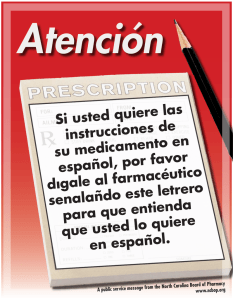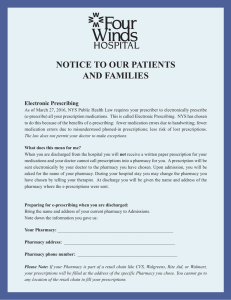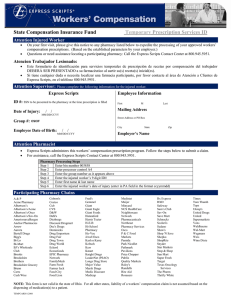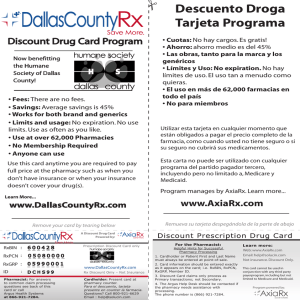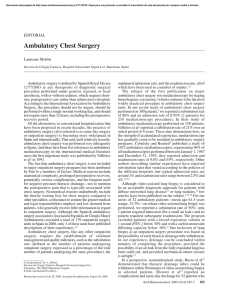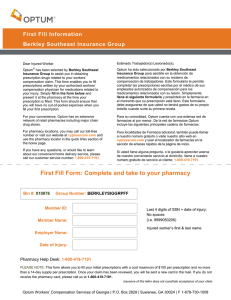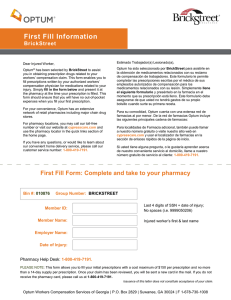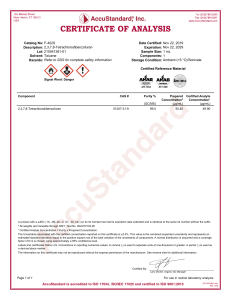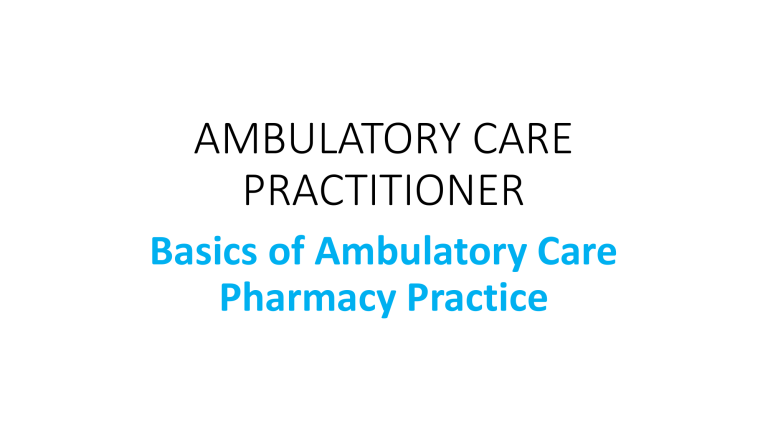
AMBULATORY CARE PRACTITIONER Basics of Ambulatory Care Pharmacy Practice Table of Contents • I. Definition: • A. What is ambulatory care pharmacy practice? • B. Where do ambulatory care pharmacists work? • C. What services do ambulatory care pharmacists provide? • II. Developing Ambulatory Care Pharmacy Services • A. How do I become an ambulatory care pharmacist? • B. How do I start ambulatory care pharmacy services? • C. What is a collaborative practice agreement and how do I create one? • III. Sustaining Ambulatory Care Pharmacy Services: • A. How do I bill for my ambulatory care pharmacy services? • B. How do I show value for my services • C. How much will I be reimbursed for my ambulatory care services? • IV. What are some barriers to expect? • V. What is the future of Ambulatory Care Pharmacy? • VI. What are some Ambulatory Care Pharmacy Practice Examples? • VII. Mentorship: I. Definition: A. What is ambulatory care pharmacy practice? • According to the Joint Working Group and BPS, “Ambulatory care pharmacy practice is • the provision of integrated, • accessible health care services by pharmacists who are accountable for addressing medication needs, • developing sustained partnerships with patients, and • practicing in the context of family and community…” • It involves being an integral part of an outpatient, multidisciplinary healthcare team to improve quality and patient outcomes by focusing on medication management. B. Where do ambulatory care pharmacists work? • BPS states, • “The ambulatory care pharmacists may work in both an institutional and community • based clinic involved in direct care of a diverse patient population” Ambulatory care pharmacists may work in the following settings • Accountable care organizations (ACO) • Community based or free clinics • Community pharmacies • Federally Qualified Health Centers (FQHC) • Hospital-based outpatient clinics • Indian Health Service Clinics • Managed care integrated system Ambulatory care pharmacists may work in the following settings • Outpatient clinics associated with academic medical centers • Patient-Centered Medical Homes (PCMH) • Private practice physician clinics • Rural Health Clinics • Self-insured employee clinics • Veterans Affairs (VA) Medical Centers • Others C. What services do ambulatory care pharmacists provide? • Ambulatory-care pharmacists provide, “... • direct patient care and medication management for ambulatory patients, • long-term relationships, • coordination of care, • patient advocacy, • wellness and health promotion, • triage and referral, and • patient education and self-management Services delivered by ambulatory care pharmacists include, but are not limited to: • Access services or care coordination • Chronic disease state management • Comprehensive medication management • Drug information • Healthcare provider education • Immunization screenings and administration • Medication reconciliation • Medication Therapy Management (MTM) • National Committee for Quality Assurance (NCQA) reporting Services delivered by ambulatory care pharmacists include, but are not limited to: • Ordering, interpreting, and monitoring laboratory tests • Participate in transitions of care, annual wellness visits, and group visits • Participate in Physician Quality Reporting System (PQRS) • Patient education and counseling • Preventative care or wellness screenings • Prospective or retrospective chart reviews • Refill authorization • Research & clinical trials • Shared visits with other healthcare providers (i.e. II. Developing Ambulatory Care Pharmacy Services: A. How do I become an ambulatory care pharmacist? • There are various credentials available for ambulatory care pharmacists: • Unique to pharmacists • BCACP – Board Certified Ambulatory Care Pharmacist • BCPS – Board Certified Pharmacotherapy Specialist • BCOP – Board Certified Oncology Pharmacist • BCGP – Board Certified Geriatric Pharmacist • BCPP – Board Certified Psychiatric Pharmacist A. How do I become an ambulatory care pharmacist? • Applicable to pharmacists and other healthcare professionals • BC-ADM – Board Certified – Advanced Diabetes Management • CDE – Certified Diabetes Educator • CAE - Certified Asthma Educator • CTTS - Certified Tobacco Treatment Specialist (CTTS) • CLS - Clinical Lipid Specialist • CACP - Certified Anticoagulation Care Provider B. How do I start ambulatory care pharmacy services? • There are various factors to consider when starting ambulatory care pharmacy services1,2: • Overall factors to consider • Be a cooperative team member (identify practice needs and help fill those voids) • Document services and outcomes (specific to your institution; shows value) • Have open communication (share your interventions and outcomes with stakeholders) • Have patience and perseverance (may take months to years) • Identify and collaborate with a physician champion (especially those in leadership positions at your institution or those who have a positive working experience with ambulatory care pharmacists) • Obtaining “buy-in” from stakeholders (clinicians and administrators) B. How do I start ambulatory care pharmacy services? • Technical factors to consider before patient care • Documentation and data tracking • Fee for service vs value-based reimbursements • Institutional priorities and goals • Payer mix (private vs Medicare vs Medicaid vs commercial insurance) • Space (both office and clinic) • Staff support (scheduling, handling no-shows, etc.) • Workflow (will you share a medical assistant, nurse, or won’t receive help) III. Sustaining Ambulatory Care Pharmacy Services: A. How do I bill for my ambulatory care pharmacy services? •Critical questions from stakeholders will deal with billing and compensation for ambulatory care pharmacy services. Process 1. Before an initiative is undertaken, you will need to verify the service being proposed is sustainable, with a respectable return on investment, and aligns with the mission and vision of your institution1,2. There are various sources available to guide you and the stakeholders through this complicated topic1-9 2. Identify the decision-makers that may impact any portion of the billing process. Key personnel in the billing team may include, but not limited to, the clinic manager, clinic scheduler, director of pharmacy, billing department and coding specialist(s), marketing, information technology (IT), chief compliance officer, and others. 3. Schedule individual meetings with each of them. Be prepared to present your proposed services. Ask their perspective and what they believe will be barriers to the proposed initiatives. Process • 4. If you do not already have one, with the help of the credentialing department, apply for a national provider identifier (NPI)10 • 5. Once you have met with all of them individually, and have a list of their challenges, find evidence-based solutions to those perceived barriers. • 6. Form a committee and schedule a meeting with all of the billing stakeholders where you will present them with a summary of your plan, including solutions to their challenges. • 7. Create an action-plan from the meeting (SMART11 goals or another similar format is recommended) and schedule recurring meetings to keep the momentum in your favor. • 8. Once billing is occurring for your services, follow up with stakeholders through committee and/or individual meetings to assure quality and accuracy.
